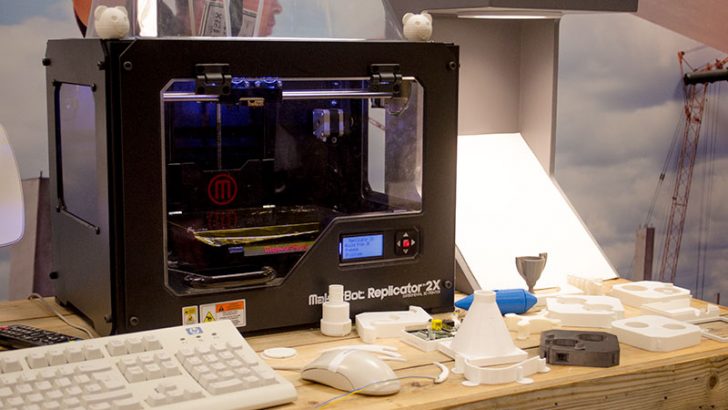
SAP is opening up its 3D Printing Early Access Program to more customers. The program is part of the SAP Distributed Manufacturing application and is a part of a joint collaboration with carrier UPS. The agreement was signed back in May 2016. Since then 28 companies have joined the program. They are working to test and approve 3D printing ahead of SAP Distributed Manufacturing going live later this year.
Can 3D printing reduce costs and speed delivery?
What impact can 3D printing really have for manufacturers and distribution? That is what this study is about. It is not just looking at reductions in manufacturing costs. There are other costs that can be harder to quantify. A manufacturer might be able to make a component for mere pennies. For a retailer, the cost of a 3D printer, the base materials and the license to print can be much more. It is also difficult to quantify the return on investment for 3D printing.
Time is also an issue that has to be considered. A manufacturing plant might produce hundreds or thousands of a component per hour. 3D printing might take an hour or more to create one. This is why scalability is a significant part of this model. However, factor in shipping and this issue changes considerably. Unless the part is on the shelf there are delays in moving it through the distribution channel. This program aims to look at how to find a reasonable balance between speed of existing technology and speed of distribution.
One solution is to consider large scale industrial 3D printing machines at major distribution hubs. The distributor or even key shipping partners would then do longer runs of components. This would eliminate significant carbon costs and make the process greener and potentially speed things up.
The challenge of Intellectual Property licensing
The IP licensing model is also a major concern. A 3D model is a perfect copy of the original. Any distributed 3D manufacturing process has to allow the IP rights owner to enforce use of the 3D model. This is something that worries manufacturers. They look at digital media and see how quickly the copyright owners lost control and money. It is understandable that they are rightly concerned that this could happen to them. 3D printers are not linked to systems that record the use of each underlying model.
There is another issue around licensing – cost. How much would a manufacturer charge per replicated component? Global warming and carbon footprint are issues that concern manufacturers. However, few consumers care about the carbon footprint of the goods they consume. Consumers might even think goods should be cheaper as there are little to no distribution costs. This means that manufacturers will have to find an IP license model that allows the retailer to justify the ROI for equipment purchase, materials and the IP per component reproduced.
This is not the only model. There is an alternatives and that is the manufacturer provides the 3D printing equipment. They could then control what 3D models can be used and how. This model only works, however, on sites the manufacturer owns. Distributors and retailers are not going to want lots of 3D printing devices tied to single manufacturers. This is just not space efficient.
SAP seeing early solutions and successes

Many of the partners involved in 3D printing are focused on the issues of tools. According to Gonzalo Rey, chief technology officer, Moog Inc: “At Moog we are both suppliers and consumers of additive manufacturing as a service. Our collaboration with SAP is accelerating the development of the tools necessary to find the best candidates for 3D printing. As a service, these tools can help accelerate the adoption process for everyone.”
Rey is not the only company that is willing to offer comment on the program so far. Nikolai Zaepernick, senior vice president, EOS Central Europe said: “This SAP program is a perfect fit for us. It provides an ideal collaboration platform to merge supply and demand for the industrial 3D printing technology we offer. As a leader in this field, EOS contributes a wealth of deep and long-standing technology experience. The platform, on the other hand, enables us to integrate our technology into existing supply chains and production environments on the way to becoming an established way of manufacturing.”
Conclusion
3D printing has been a “coming soon” technology for some time. The costs of the 3D printers are coming down as are the materials. The problem is in the time taken to manufacture anything. Industrial 3D printers are getting faster but are light years behind traditional manufacturing plants. This is not seen as a barrier to some manufacturers who see it as reducing their shipping and potential inventory costs. It also allows them to claim their processes are more eco-friendly if product is made locally.
The key to success here, as identified by SAP is not just manufacturers but the distribution channel. If shippers such as UPS can be persuaded to do 3D printing locally then there are gains to be made here as well. The challenge is making it cost and time effective. This still leaves open the question as to how close to the consumer can 3D printing get.
Despite all of these challenges, SAP is getting much closer to launching the SAP Distributed Manufacturing application. Once that happens we will get a better idea of the costs and savings that 3D printing is actually able to deliver.


























seems a great step towards knowing the actual costs and savings with 3D printing. As a part of 3D printing service industry i highly appreciate systems like this.